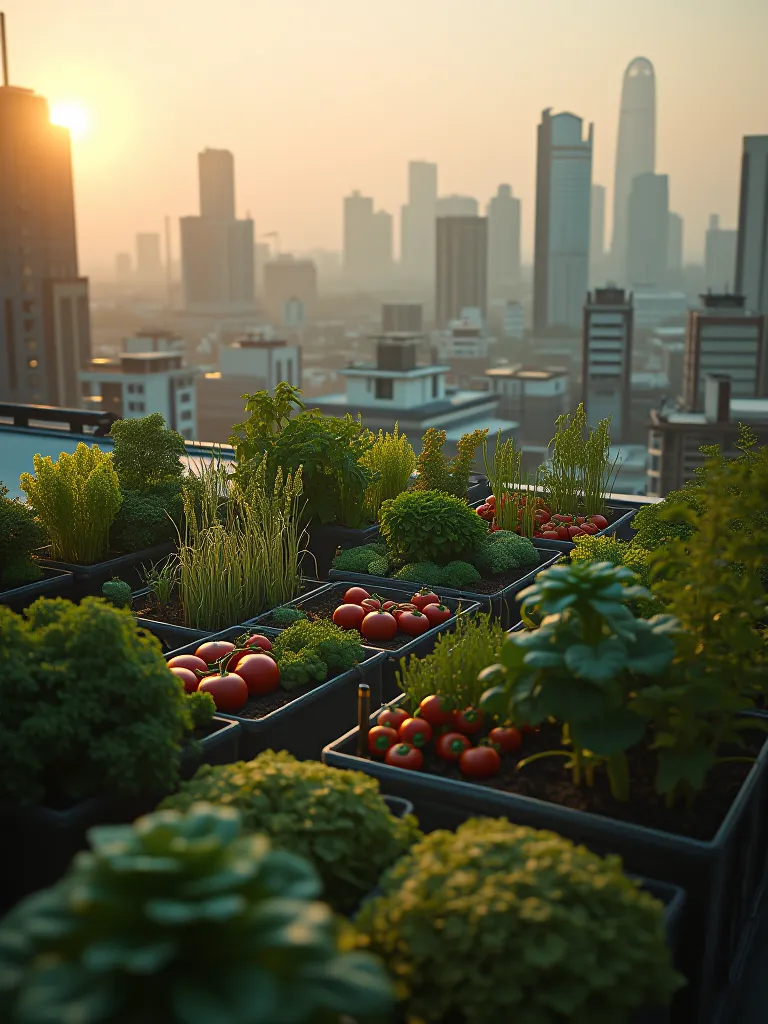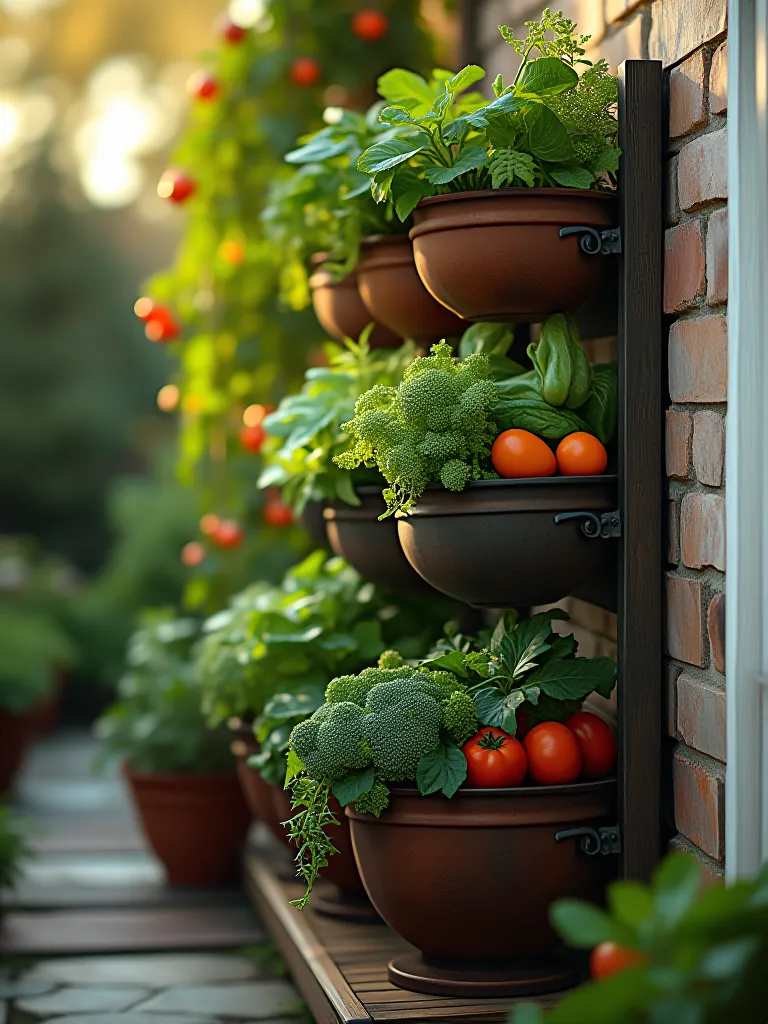Imagine stepping onto your balcony, the morning sun warming your face as you pluck a ripe tomato from its vine. This is the joy of harvesting container vegetables – a practice that’s transforming urban spaces into pockets of green abundance. As someone who’s turned my compact Portland loft into a thriving oasis of potted produce, I can attest to the satisfaction of growing and harvesting your food, no matter how limited your space might be.
In this guide, we’ll explore the art of harvesting container vegetables, from identifying the perfect moment to pick to preserving your bounty for months to come. Whether you’re a seasoned container gardener or just starting your journey into container vegetable gardening, these tips will help you maximize your yield and minimize waste. Let’s dive into the world of urban harvesting, where every square inch counts and every vegetable is a small victory in sustainable living.

Identifying Harvest Time: The Art of Perfect Timing
When it comes to harvesting container vegetables, timing is everything. It’s like waiting for the perfect moment to capture a photograph – rush it, and you miss the full potential; wait too long, and the opportunity slips away. Let’s explore how to recognize when your container-grown vegetables are ready for their debut on your dinner plate.
Signs of Ripeness: Nature’s Color Palette
When harvesting container vegetables, nature provides us with a vibrant spectrum of cues:
- Tomatoes: Look for a deep, uniform color. Most varieties transition from green to red but don’t forget about the golden yellows and deep purples of heirloom varieties.
- Peppers: These chameleons of the vegetable world often start green before maturing to their final hue – be it red, yellow, or even chocolate brown.
- Cucumbers: Seek a deep green color and firm texture. Overripe cucumbers tend to yellow and become soft.
- Zucchini: Harvest when they reach 6-8 inches long and have rich, dark green skin.
- Eggplants: Look for a glossy sheen and slight give when gently pressed.
Remember, color is just one piece of the puzzle. Combine these visual cues with size and firmness to ensure you’re harvesting at peak ripeness.

Feeling Your Way to Freshness
Touch is an invaluable tool when harvesting container vegetables:
- Tomatoes: Should yield slightly to gentle pressure but not feel soft.
- Peppers: Firm to the touch with a slight give.
- Cucumbers: Firm throughout with no soft spots.
- Zucchini: Should feel firm and heavy for their size.
- Eggplants: A slight give when gently squeezed indicates readiness.
Size Matters: When Bigger Isn’t Always Better
While it’s tempting to let vegetables grow as large as possible, size can be deceiving:
- Zucchini: Smaller (6-8 inches) often means more tender and flavorful.
- Cucumbers: Harvest when 6-8 inches long for slicing varieties, or 2-4 inches for pickling types.
- Green Beans: Pick when pods are slim and crisp before seeds become visible through the pod.
- Radishes: Pull when they reach about an inch in diameter for the best flavor and texture.
By combining these visual, tactile, and size-based cues, you’ll develop an intuitive sense for harvesting container vegetables at their peak. Happy harvesting!

Nature provides us with a vibrant palette of colors to indicate ripeness. Take tomatoes, for instance – they transform from a modest green to a rich, inviting red (or yellow, or even purple, depending on the variety). Peppers, too, are nature’s little color-changers, often starting green before maturing into their final vibrant hues.
But color isn’t the only indicator. The firmness of your vegetables can tell you a lot about their readiness. A ripe cucumber should feel firm with just a whisper of give, while a zucchini should be firm throughout. It’s like choosing the perfect avocado for your morning toast – there’s an art to it that comes with practice.
Best Harvest Seasons: Dancing with the Calendar
Harvesting container vegetables is a year-round affair, each season bringing its stars to the show. Spring ushers in tender lettuces and crisp peas, while summer is the time for juicy tomatoes and peppers to shine. As autumn’s cooler breezes arrive, root vegetables like carrots and beets take center stage.
But here’s the beauty of container gardening – you can often extend these seasons. With a bit of protection, you might find yourself harvesting tender greens well into the cooler months or getting an early start on summer crops. It’s like having a time machine for your taste buds!
Tools for Harvesting: The Right Gear for the Job
When it comes to harvesting container vegetables, think of your tools as extensions of your hands. A pair of sharp scissors or pruners are indispensable for clean cuts that won’t damage your plants. For root vegetables, a small hand trowel becomes your treasure-hunting companion, gently unearthing potatoes and carrots.

And don’t forget about your harvest basket! Choose something lightweight and breathable – I love using repurposed colanders or vintage wire baskets. They’re not just practical; they add a touch of charm to the harvesting process. After all, who says functionality can’t be stylish?
Common Mistakes to Avoid: Learning from Nature’s Lessons
In the world of harvesting container vegetables, patience truly is a virtue. It’s tempting to pluck that almost-ripe tomato, but resist the urge! Harvesting too early can lead to disappointment in both flavor and texture. On the flip side, waiting too long can result in overripe, sometimes inedible produce.
Another rookie mistake is harvesting without care. Yanking vegetables forcefully can damage both the fruit and the plant. Instead, approach harvesting with mindfulness – it’s a moment to connect with your plants and appreciate their bounty.
Lastly, don’t fall into the “out of sight, out of mind” trap. Regular check-ins with your container garden ensure you catch each vegetable at its peak. It’s like tending to a friendship – consistent attention leads to the best results.
Optimal Storage Methods: Preserving Your Garden’s Gifts
Now that you’ve mastered the art of harvesting container vegetables, let’s talk about keeping that hard-earned produce fresh and delicious. Proper storage is like giving your vegetables a cozy home after their journey from plant to kitchen. It’s all about understanding what each type of vegetable needs to stay at its best.

Short-Term Storage Tips: A Place for Everything
When it comes to short-term storage of your freshly harvested container vegetables, think of your kitchen as a miniature ecosystem. Each vegetable has its preferred environment:
- Leafy greens like lettuce and spinach thrive in the refrigerator’s crisper drawer. Wrap them loosely in a damp paper towel and tuck them into a perforated plastic bag. It’s like creating a mini-spa for your greens!
- Tomatoes, on the other hand, prefer room temperature. Storing them on your countertop not only preserves their flavor but also adds a pop of color to your kitchen. Just be sure to keep them out of direct sunlight.
- Root vegetables like carrots and beets are the camels of the vegetable world – they prefer cool, dark places. A paper bag in the coolest part of your pantry works wonders.
Remember, the types of containers for gardening can affect how quickly your vegetables mature, so keep an eye on your harvest times!
Long-Term Storage Techniques: Preserving the Harvest
For those bountiful harvests that exceed your immediate needs, long-term storage is key. Think of it as a way to capture summer’s flavors for those grey winter days:
- Freezing is a fantastic option for many vegetables. Blanch items like green beans or peas before freezing to preserve their color and nutrients. It’s like pressing pause on their freshness!
- Canning and pickling are time-honored traditions that not only preserve your harvest but can transform it. Imagine opening a jar of homemade pickles in the depths of winter – it’s like a taste of summer sunshine.
- Dehydrating is perfect for herbs and some vegetables like tomatoes. It concentrates flavors and makes storage a breeze. Plus, there’s something deeply satisfying about seeing jars of dried herbs lining your shelves.

Temperature and Humidity Control: Creating the Perfect Environment
Controlling temperature and humidity is crucial when storing your harvested container vegetables. Think of it as creating a spa retreat for your produce:
- Most vegetables prefer temperatures between 32-40°F (0-4°C). Your refrigerator is ideal for this, but a cool basement can work for some hardier vegetables.
- Humidity is equally important. Leafy greens love high humidity (about 95%), while root vegetables prefer it a bit drier (around 85%). A simple hygrometer can help you monitor these conditions.
- For those without specialized storage areas, don’t fret! Even small adjustments, like using perforated plastic bags or adding a damp paper towel to containers, can make a big difference.
Containers for Storage: Finding the Perfect Home
Choosing the right containers for storing your harvested vegetables is like selecting the perfect outfit – it needs to suit the occasion and the individual:
- Breathable containers, like mesh bags or baskets, are ideal for vegetables that need air circulation. Think onions and garlic.
- Airtight containers are perfect for leafy greens and herbs, helping to retain moisture and prevent wilting.
- Glass jars are great for pickled vegetables or dried herbs. They’re not just functional; they add a touch of rustic charm to your pantry.
- Reusable produce bags are a sustainable choice for storing a variety of vegetables in the fridge. They’re like cozy sleeping bags for your veggies!

Remember, the potting soil for vegetables you use can affect the storage life of your harvest, so choose wisely from the start!
Extending Freshness and Shelf Life: Maximizing Your Harvest
After all the care you’ve put into growing and harvesting container vegetables, the last thing you want is to see them wilt away before you can enjoy them. Extending the freshness and shelf life of your produce is like giving your vegetables a second wind, allowing you to savor your harvest for weeks or even months to come.
Cleaning and Preparing Vegetables: The First Step to Longevity
Think of cleaning your freshly harvested vegetables as a spa treatment – it’s all about pampering them for longevity:
- Start with a good rinse under cool running water. This isn’t just about cleanliness; it’s about respecting your produce and preparing it for storage.
- For leafy greens, a salad spinner is your best friend. It removes excess water that can lead to premature wilting.
- Root vegetables like carrots and beets benefit from having their tops removed before storage. This prevents the leaves from drawing moisture from the roots.
- Herbs can be treated to a gentle bath and then patted dry before being wrapped loosely in paper towels.
Remember, gentle handling during this process sets the stage for longer-lasting produce.

Using Preservation Methods: Capturing Flavors in Time
Preserving your harvest is like capturing a moment in a bottle – it allows you to enjoy the fruits (or vegetables) of your labor long after the growing season has ended:
- Fermentation is a fantastic way to extend shelf life while creating new, complex flavors. Sauerkraut or kimchi made from your homegrown cabbage is not just delicious; it’s alive with beneficial bacteria.
- Vacuum sealing is perfect for freezing vegetables. It’s like giving your produce a protective shield against freezer burn.
- Oil preservation works wonders for herbs. Imagine having garden-fresh basil or rosemary on hand all year round – it’s like a time capsule of summer flavors.
Benefits of Proper Storage: Why It Matters
Proper storage of your harvested container vegetables isn’t just about preventing waste; it’s about respecting your hard work and the resources that went into growing your food:
- Extended shelf life means less frequent trips to the grocery store, saving you time and reducing your carbon footprint.
- Preserving nutritional value ensures that you’re getting the maximum health benefits from your homegrown produce.
- Maintaining flavor means you can enjoy garden-fresh taste even in the depths of winter.
- Reducing food waste is not just good for your wallet; it’s a small but significant step towards a more sustainable lifestyle.

Minimizing Waste Strategies: Making the Most of Every Harvest
In the world of harvesting container vegetables, the goal is to use every part of the plant possible. It’s about adopting a zero-waste mindset:
- Compost any unused parts of your vegetables. It’s like giving back to the earth that nourishes your plants.
- Get creative with recipes that use the entire vegetable. Carrot top pesto or pickled watermelon rinds are delicious ways to reduce waste.
- Share your abundance with neighbors or local food banks. It’s a beautiful way to build community and ensure nothing goes to waste.
- Plan your meals around your harvest. It’s like letting your garden dictate your menu – a delicious challenge for any home cook!
Final Remarks: Embracing the Cycle of Growth
As we wrap up our journey through the world of harvesting container vegetables, I’m reminded of the beautiful cycle we participate in as urban gardeners. From the moment we plant a seed to the final bite of our homegrown produce, we’re connected to something larger than ourselves – the timeless rhythm of growth and nourishment.
Harvesting container vegetables is more than just a practical skill; it’s a way to bring a bit of nature’s magic into our often concrete-dominated lives. It teaches us patience as we wait for that perfect moment of ripeness, mindfulness as we carefully pluck each fruit or leaf, and creativity as we find ways to store and use our bounty.

Remember, every time you harvest from your container garden, you’re not just picking vegetables – you’re reaping the rewards of your care and attention. You’re proving that even in the smallest of spaces, we can cultivate abundance. And with each meal featuring your homegrown produce, you’re nourishing not just your body, but your connection to the earth and the seasons.
So, whether you’re tending to a sprawling balcony garden or nurturing a single tomato plant on your windowsill, take pride in your role as an urban harvester. Embrace the learning process, celebrate your successes, and don’t be afraid to get your hands dirty. After all, that’s where the best stories – and the best vegetables – come from.
Happy harvesting, and may your containers always be bountiful!






